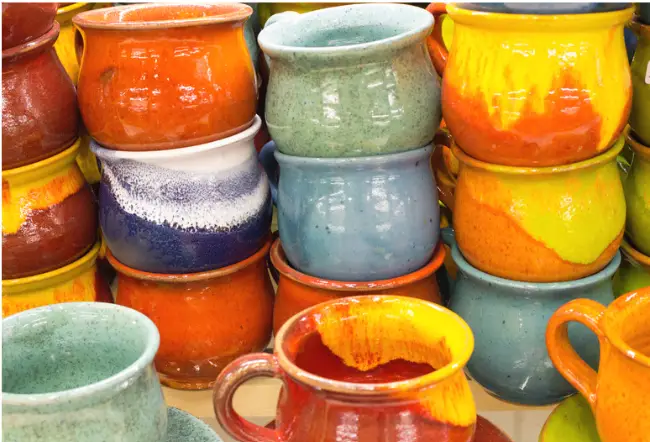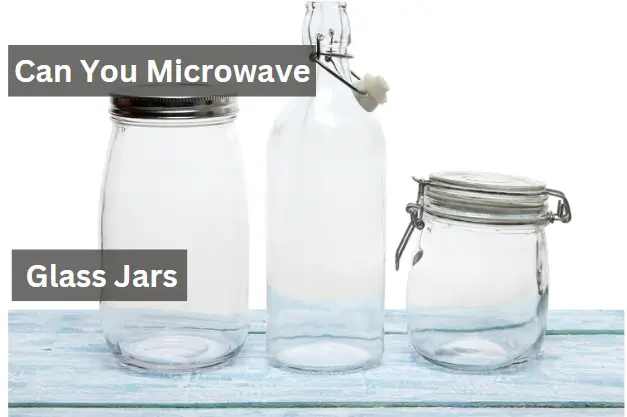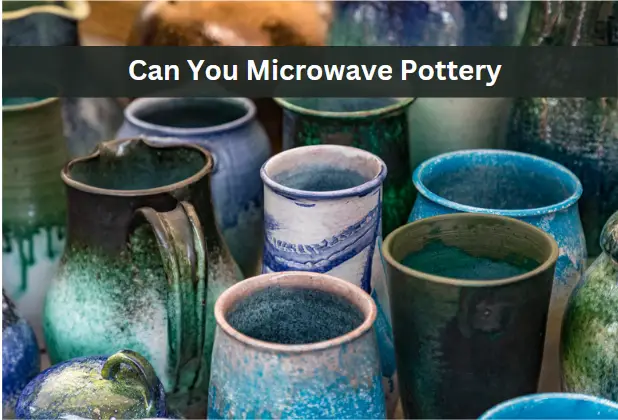Can You Microwave Ceramic Mugs? How To Guide
I can still remember the day I first encountered ceramic mugs – going out for coffee with my best friend and seeing all the beautiful designs and stark colors that glowed from each mug up against the sunshine streaming through the café window.
Since then, ceramic mugs have been an essential part of my kitchen, helping to keep my coffee warm while making my mornings more enjoyable.
But while these avant-garde vessels can work wonders in the realm of aesthetics, many people can’t help but wonder if they can put them in the microwave?
Can you microwave ceramic mugs? After doing some research, I can confidently say, yes! However, it’s important to keep a few things in mind before venturing into this brave new world of microwaved ceramics.
Let’s dive right in!
Can You Microwave Ceramic Mugs?
Yes, you can microwave ceramic mugs. In fact, most ceramics are safe to use in the microwave. However, it’s important to be aware of a few things before microwaving your ceramic mug.
Find the Microwave-Safe Label
First, make sure that the mug is labeled as microwave-safe or check with the manufacturer if you’re unsure. You can generally find this out by looking on the bottom of the mug.
Do NOT Microwave Glazed or Decorated Ceramic Mugs
Second, avoid microwaving mugs that have metallic accents or decorations as these can cause sparks and damage to your microwave.
Look for Cracks
It may seem like a minor issue, but microwaving a cracked ceramic mug can be dangerous. Here’s why you shouldn’t do it:
- Risk of injury: When a ceramic mug is cracked, it weakens the structure of the mug. Microwaving it can cause the mug to break apart, potentially causing burns from hot liquid or sharp pieces of ceramic.
- Leakage of harmful chemicals: Ceramic mugs are often coated with glaze to make them waterproof and easier to clean. However, if the glaze is compromised due to cracks, it can release harmful chemicals into your food when microwaved. These chemicals include lead and cadmium, which can cause serious health problems if ingested.
To avoid these risks, it’s best to dispose of any cracked ceramic mugs and use microwave-safe alternatives such as glass or plastic containers. Stay safe while enjoying your favorite microwave meals!
Be Careful Removing Ceramic Mugs From the Microwave
Finally, be careful when removing the mug from the microwave as it may be hot.
Ceramic: A Versatile Material
Ceramic is a type of material that is hard, brittle, and resistant to heat and corrosion. It is made by shaping and firing inorganic materials such as clay, earthen minerals, powders, and water. Once fired, ceramics can be glazed or decorated to create beautiful and functional objects.
There are several types of ceramics available today. Some of the most common types include:
Earthenware
Earthenware is a type of ceramic that is fired at low temperatures. It is porous and often used for decorative purposes.
Stoneware
Stoneware is a type of ceramic that is fired at high temperatures. It is non-porous and often used for making dishes and other functional objects.
Porcelain
Porcelain is a type of ceramic that is made from fine clay and fired at very high temperatures. It has a translucent appearance and is often used for making delicate objects such as vases or figurines.
Ceramics have been used for thousands of years to create everything from pottery to electronics components. With its versatility, durability, and beauty, it’s no wonder why ceramics continue to be an important material in our daily lives.
How Are Ceramic Mugs Made?
Ceramic mugs are a popular choice for coffee and tea drinkers alike. But have you ever wondered how these mugs are made? In this article, we’ll take a closer look at the process of making ceramic mugs.
The Process of Making Ceramic Mugs
Step 1: Preparing the Clay
The first step in making a ceramic mug is preparing the clay. The clay used for making ceramics is usually a mixture of different types of clay, such as kaolin, ball clay, and fire clay. These clays are mixed together with water to create a smooth, workable consistency.
Step 2: Shaping the Mug
Once the clay is prepared, it’s time to shape the mug. There are several ways to do this, but one common method is to use a pottery wheel. The potter will place a ball of clay on the wheel and use their hands to shape it into a cylinder. They will then use their fingers to create an indentation in the top of the cylinder, which will become the opening for the mug.
Step 3: Drying and Firing
After shaping the mug, it needs to dry before it can be fired in a kiln. This can take anywhere from several hours to several days depending on the size and thickness of the mug. Once dry, it’s ready for its first firing in a kiln at temperatures ranging from 1,800°F to 2,400°F.
Step 4: Glazing and Firing Again
After the first firing, it’s time to glaze the mug. Glaze is a liquid coating that’s applied to ceramics before they’re fired again in a kiln. This second firing melts the glaze onto the surface of the mug and creates a smooth, glossy finish.
Step 5: Quality Control
Once fired and cooled down completely, each ceramic mug undergoes quality control checks before being packaged up for shipping or sale.
And there you have it! A brief overview of how ceramic mugs are made. From preparing the clay to shaping and firing in a kiln twice with glazing in between, each step requires skillful craftsmanship that results in beautiful handmade pieces that we all love using every day!
Is it Safe to Microwave Ceramic Mugs?
If you’re someone who loves to enjoy a hot cup of coffee or tea, you may be wondering if it’s safe to microwave your ceramic mug. The good news is that most ceramic mugs are safe to use in the microwave, but there are a few things you should keep in mind.
Firstly, it’s important to check your mug for any metallic accents or decorations before microwaving it. Metallic materials can cause sparks and potentially damage your microwave. If your mug has any metallic elements, it’s best to avoid microwaving it altogether.
Secondly, be cautious when removing your mug from the microwave as it can become very hot. Use oven mitts or a towel to protect your hands from burns.
Lastly, make sure your ceramic mug is labeled as “microwave-safe” before using it in the microwave. While most ceramic mugs are safe for this purpose, some may not be and could potentially crack or break under the heat.
In summary, if you follow these precautions and ensure that your ceramic mug is safe for microwave use, you can enjoy a warm beverage without any worries.
How to Test if Your Ceramic Mug is Microwave Safe
If you’re unsure whether your ceramic mug is safe to use in the microwave, there are a few simple tests you can do at home. Here’s how:
- Look for a “microwave-safe” label on the bottom of the mug. If you see one, you’re good to go!
- If there’s no label, fill the mug with water and place it in the microwave alongside a microwave-safe container 3/4 filled with water. Make sure you know for a fact the second dish IS microwave-safe. We suggest using a Pyrex dish.
- Heat both containers for one minutes on high power.
- Carefully remove both containers from the microwave and check the temperature of the water in each one.
- If the water in the mug in questions is significantly hotter than the water in the other container, or if the mug itself feels hot to the touch, it may not be safe to use in the microwave. If the mug in question is cooler to touch while there is warm water in it, it is microwave safe.
Remember that even if your ceramic mug passes these tests, it’s still important to use caution when heating liquids in it. Always start with short heating times and monitor your drink closely to avoid overheating or spills.
How Long Can You Microwave a Ceramic Mug?
If you’re a fan of quick and easy meals, then you’ve probably tried using your microwave to cook or heat up food. But have you ever wondered how long you can microwave a ceramic mug?
The answer is that it depends on the type of ceramic and the wattage of your microwave. Generally, most ceramic mugs are safe to use in the microwave for short periods of time, such as heating up a cup of coffee or tea for 30-60 seconds. However, if your mug has metallic accents or is handmade with glazes that contain lead or other harmful materials, it’s best to avoid microwaving it altogether.
To be on the safe side, always check the manufacturer’s instructions before microwaving any ceramic dishware. If there are no instructions available, start with short intervals of 15-20 seconds and check the temperature of the mug before continuing to heat it up.
Are Ceramic Glazed Mugs Microwave Safe?
If you’re someone who loves their morning cup of coffee or tea, you might have wondered whether your ceramic glazed mug is safe to use in the microwave. While most ceramics are safe for microwave use, there are some exceptions to this rule, such as glazed ceramic mugs.
Ceramic glazed mugs are coated with a layer of glaze that contains metal oxides and other compounds. When exposed to high temperatures in the microwave, these compounds can potentially release harmful chemicals into your food or drink. This is especially true if the glaze contains lead or cadmium, which can cause serious health problems if ingested.
We do not recommend microwaving any ceramic glazed mugs, even if they have a microwave safe label.
If you do decide to microwave your ceramic glazed mug, take some precautions to minimize any potential risks. First, make sure that the mug is clean and free of any cracks or chips that could cause it to break in the microwave. Second, avoid microwaving acidic foods or drinks in your mug as they can react with the glaze and release harmful chemicals. Finally, keep an eye on your mug while it’s in the microwave and stop heating it immediately if you notice any unusual smells or signs of damage.








